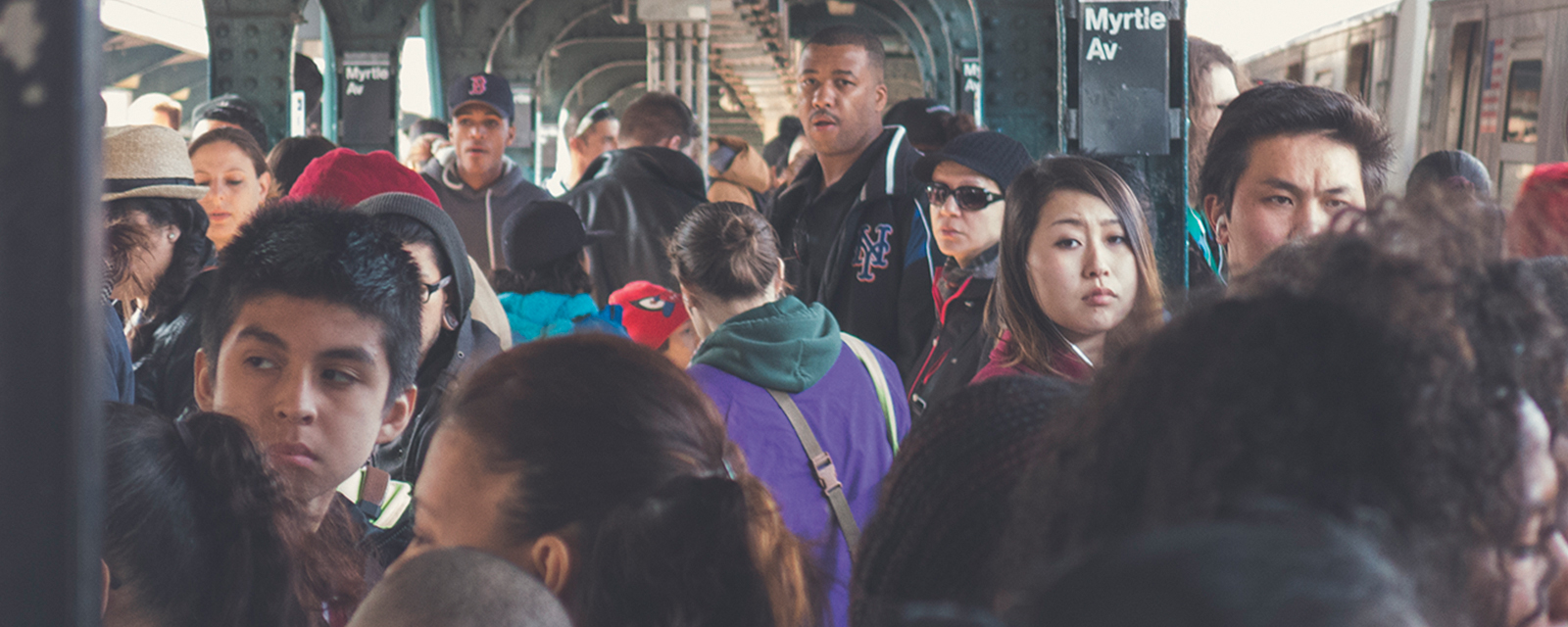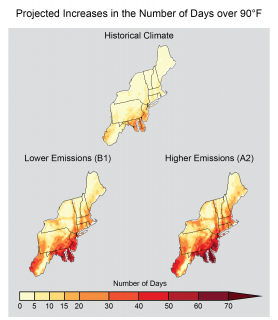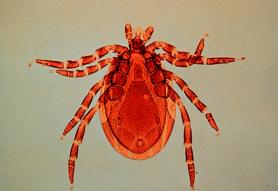
People and Communities
Average temperature in the Northeast rose by almost 2°F between 1895 and 2011. By the 2080s, climate models project that the region could see additional warming of 3°F–6°F (low emission scenario) or 4.5°F–10°F (high emission scenario). Under either emission scenario, heat waves in the region are expected to be more frequent, more intense, and last longer as the century progresses.
Most residents of the Northeast live in cities. Because urban areas have higher concentrations of concrete and asphalt and a relative lack of vegetation compared to more rural areas, they tend to have higher temperatures—sometimes, several degrees higher—both in the daytime and at night. This is known as the urban heat island effect. When city dwellers don't have an opportunity to cool down at night, they face an increased risk for heat-related illnesses.
As the region's average temperatures rise, extended periods of heat may also become an issue in small towns and rural areas of the Northeast. Residents may be unprepared for heat hazards because historically, heat waves have been rare in the region, and many homes lack air conditioning.
Warmer temperatures are associated with reduced air quality through higher levels of ground-level ozone and other pollutants. The combination of heat stress and poor air quality can pose a major health risk to vulnerable groups: young children, the elderly, and those with pre-existing health conditions, such as asthma.
People become more vulnerable to heat waves when key infrastructure fails. For example, when increased demand for electricity to power fans or air conditioning exceeds the available supply, people can't cool down and may become ill. Socioeconomic factors can also increase populations' vulnerability to heat hazards: examples include race and ethnicity (being a minority), age (the elderly and children), gender (female), socioeconomic status (low income status or poverty), and education (low educational attainment).
Learn more about heat health for outdoor workers in a story map created by the National Integrated Heat Health Information System (NIHHIS) team. Story maps are web applications that combine maps, images, multimedia content, and narrative text. Open the story map "Protecting Outdoor Workers from Heat Illness" in a new tab/window.
In contrast to heat waves, the frequency, intensity, and duration of cold air outbreaks across the Northeast is expected to decrease. This change will reduce the need for—and cost of—winter heating needs. Some research, however, suggests that loss of Arctic sea ice could affect this trend. For more information on this area of active research, see the Arctic-Global Linkages page. Over the next few decades, it's likely that residents in the Northeast will continue to experience occasional cold snaps and extreme winter storms.
Another impact of concern is a possible increase in vector-borne diseases—those carried by vectors, such as ticks and mosquitoes. Currently, most occurrences of Lyme disease in the United States are found in the Northeast. While it's unclear what affect climate change may have on Lyme disease, some research has linked tick activity and the incidence of Lyme disease to abundant late spring and early summer moisture. Climate change is expected to increase the suitable habitat for some species of mosquito—such as those that carry the Zika and West Nile viruses—and other disease vectors over the next century.
Increasingly frequent heavy precipitation events can have a negative affect on water quality and thus increase the incidence of waterborne disease. Many large Northeastern cities, including New York, Boston, and Philadelphia, have combined sewer systems that collect and treat both stormwater and municipal wastewater. These combined systems can become overwhelmed during heavy downpours, resulting in untreated effluent overflowing the system and pouring into nearby waterways.
More frequent heavy precipitation events also lead to an increased risk of flooding for people who live along rivers or in their floodplains. And, as sea levels rise, people living in coastal areas will be exposed to more frequent flooding from tropical storms and nor'easters. These changes increase flood risks for the approximately 1.6 million residents who live within the 100-year coastal flood zone designated by the Federal Emergency Management Agency, 63 percent of whom reside in New York and New Jersey. Furthermore, residents who live outside the current flood zone could find themselves within it as the century progresses and sea levels rise. Coastal and riverine flooding directly threatens residents' lives and safety, as well as personal property, businesses, and infrastructure.
The preceding text is excerpted and abridged from Climate Change Impacts in the United States: The Third National Climate Assessment (Chapter 16: Northeast).
To learn more about climate-related impacts on people and human communities, visit Topics. The following topics may be particularly helpful:





